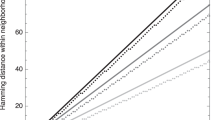Abstract
It is shown that complex adaptations are best modelled as discrete processes represented on directed weighted graphs. Such a representation captures the idea that problems of adaptation in evolutionary biology are problems in a discrete space, something that the conventional representations using continuous adaptive landscapes does not. Further, this representation allows the utilization of well-known algorithms for the computation of several biologically interesting results such as the accessibility of one allele from another by a specified number of point mutations, the accessibility of alleles at a local maximum of fitness, the accessibility of the allele with the globally maximum fitness, etc. A reduction of a model due to Kauffman and Levin to such a representation is explicitly carried out and it is shown how this reduction clarifies the biological questions that are of interest.
Similar content being viewed by others
References
Bock, W. J.: 1980, ‘The Definition and Recognition of Biological Adaptation’, American Zoologist 20, 217–227.
Christofides, N.: 1975, Graph Theory: An Algorithmic Approach, Academic Press, New York.
Darwin, C.: 1859, On the Origin of the Species, John Murray, London.
Dijkstra, E. W.: 1959, ‘A Note on Two Problems in Connexion with Graphs’, Numerische Mathematik 1, 269–271.
Gibbons, A.: 1985, Algorithmic Graph Theory, Cambridge University Press, Cambridge.
Gould, S. J. and R. Lewontin: 1979, ‘The Spandrels of San Marco and the Panglossian Paradigm: A Critique of the Adaptationist Programme’, Proceedings of the Royal Society of London B 205, 581–598.
Gould, S. J. and S. J. Vrba: 1982, ‘Exaptation — A Missing Term in the Science of Form’, Paleobiology 8, 4–15.
Kauffman, S. and S. Levin: 1987, ‘Towards a General Theory of Adaptive Walks on Rugged Landscapes’, Journal of Theoretical Biology 128, 11–45.
Lewontin, R.: 1978, ‘Adaptation’, Scientific American September, 212–228.
Papadimitriou, C. H. and K. Steiglitz: 1982, Combinatorial Optimization: Algorithms and Complexity, Prentice- Hall, Englewood Cliffs.
Provine, W. B.: 1986, Sewall Wright and Evolutionary Biology, University of Chicago Press, Chicago.
Williams, G. C.: 1966, Adaptation and Natural Selection, Princeton University Press, Princeton.
Wimsatt, W. C.: 1972, ‘Teleology and the Logical Structure of Function Statements’, Studies in the History and Philosophy of Science 3, 1–80.
Wright, S.: 1932, ‘The Roles of Mutation, Inbreeding, Crossbreeding and Selection in Evolution’, Proceedings of the Sixth International Congress of Genetics Volume 1, pp. 356–366.
Author information
Authors and Affiliations
Additional information
Thanks are due to William Wimsatt, James F. Crow, and the referees for Biology and Philosophy for comments on an earlier version of this paper. Remarks by members of the audience, especially Abner Shimony, of a seminar at Boston University, February 19, 1988, were also very helpful. The diagrams were prepared with the assistance of Tracy Lubas.
Rights and permissions
About this article
Cite this article
Sarkar, S. On adaptation: A reduction of the Kauffman-Levin model to a problem in graph theory and its consequences. Biol Philos 5, 127–148 (1990). https://doi.org/10.1007/BF00127484
Issue Date:
DOI: https://doi.org/10.1007/BF00127484




